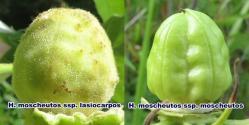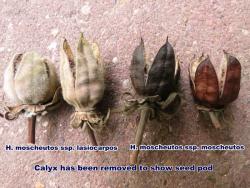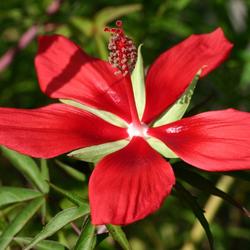When a plant genus is large, botanists will sometimes divide the genus into sections, which are smaller groups of similar species. Hibiscus is one genus that has been divided into several sections. One of these sections is the section Muenchhusia.
This article was originally posted on October 20, 2014. It was a good gardening idea and worth seeing again, so we hope you enjoy revisiting it.
Hibiscus section Muenchhusia contains five North American species, H. coccineus, H. dasycalyx, H. grandiflorus, H. laevis, and H. moscheutos. Members of this group are sometimes called Hardy Hibiscus because they die back in the winter and re-sprout from their roots in the spring. Although any one of this group may be called Hardy Hibiscus, the name is most often applied to Hibiscus moscheutos and its cultivars. All of the members of Hibiscus section Meunchhusia will hybridize with each other and are the source of the Hardy Hibiscus cultivars found in nurseries. In nature these hibiscuses are found growing in very wet soil in swamps, marshes, and ditches. Because of this, they make excellent choices for rain gardens and bogs, but most will adapt to average garden conditions if they are kept moist and not allowed to become completely dry.
Neches River Rosemallow (Hibiscus dasycalyx) is a very rare species that is Texas endemic. There are only three confirmed populations in the wild and the species is listed by the US Government as threatened.
Scarlet Rose Mallow (Hibiscus coccineus) can grow to about 7 feet and has deep scarlet flowers that bloom in the upper leaf axils. H. coccineus has five petals that separate in a star pattern, which gives it one of its other names, Texas Star Hibiscus.
Scarlet Rose Mallow grows wild in coastal states from Texas to Virginia and also in Arkansas. The palmate, toothed leaves resemble those of marijuana and there have been reports of owners having run-ins with nosy neighbors and overzealous police officers.
Halberdleaf Rosemallow (Hibiscus laevis) is native to the eastern half of the United States and parts of Canada. H. laevis grows to about 6 feet and has white or slightly pink flowers. It gets its common name and synonym name (Hibiscus militaris) from the leaves' resemblance to the halberd weapon.
Giant Rose Mallow (Hibiscus grandiflorus) is native to the US coastal states from Texas to Georgia. The Giant Rose Mallow can reach a height of 10 feet, which makes it the true giant in this group of hibiscuses. As the name suggests, Hibiscus grandiflorus does have grand flowers. Measuring about 10 inches across, these light pink flowers are the only ones of this group that are fragrant. The blooms begin to open in early evening, remain open all night, and begin closing the next morning. The light color and fragrant, nocturnal blooms would make this a good choice for a "Moon Garden." The well-known cultivar 'Moy Grande' was created by crossing the hybrid Hibiscus moscheutos 'Southern Belle' with Hibiscus grandiflorus.
Hibiscus moscheutos has two subspecies, H. moscheutos subsp. moscheutos and H. moscheutos subsp. lasiocarpos. The flowers range from white to varying shades of pink. They usually have a red center, but can sometime be found with a clear center. Because of the variability of this plant, there have been several names applied to it by botanists. Now they are all considered synonyms, but they can still be found listed for sale under these synonyms. As you might guess, both subspecies look very much alike at first glance. Subspecies moscheutos can reach a height of about 8 feet, whereas subspecies lasiocarpos can grow to about 6 1/2 feet. Because height can vary depending on many factors, it is not a reliable way to distinguish them from one another. The best indications are the leaves and the seed pods.
The upper surface of subspecies moscheutos is a dark green with no pubescence. The underside is pubescent, but this may be hard to see because the short stellate hairs lie flat against the leaf surface.

Both leaf surfaces of subspecies lasiocarpos are pubescent and velvety to the touch. Due to the pubescence, the upper surface is a much lighter color than that of subspecies moscheutos.

The seed pods can be distinguished in much the same way as the leaves. Hibiscus moscheutos subsp. moscheutos is glabrous and Hibiscus moschuetos subsp. lasiocarpos is pubescent. The photos below show how each of the subspecies looks with both green pods and mature dry pods.


All of the above species are commercially available.





